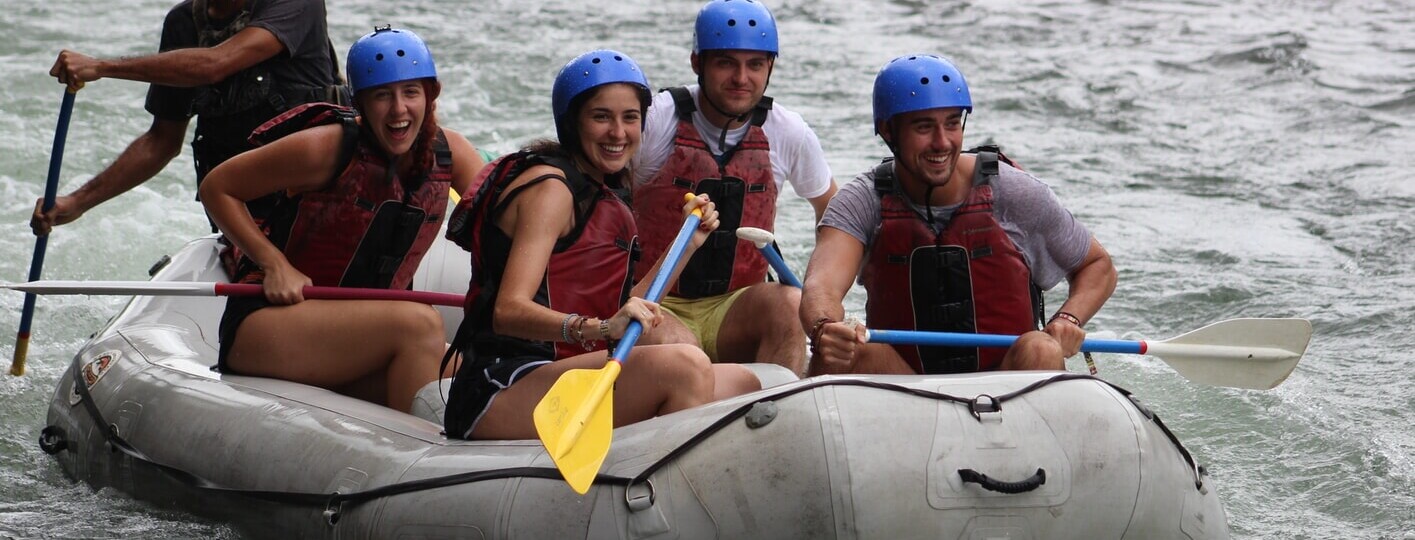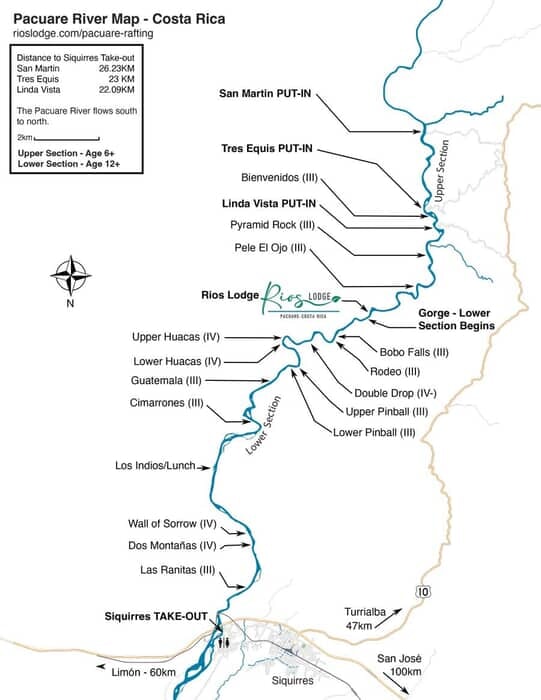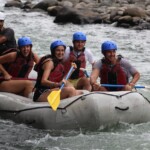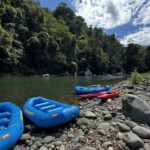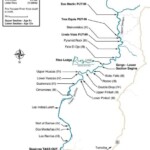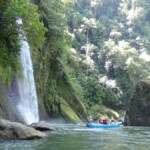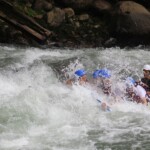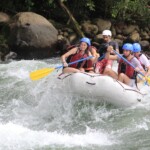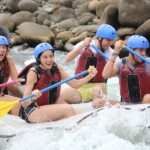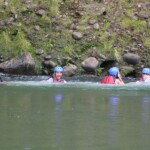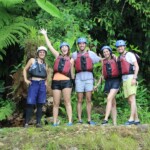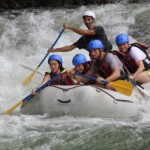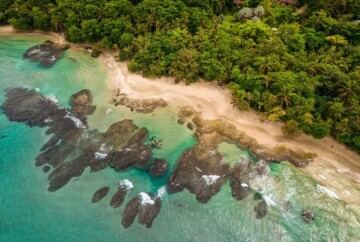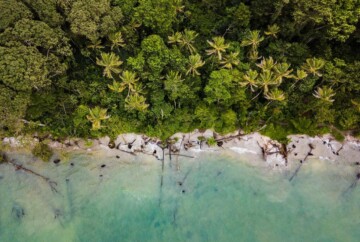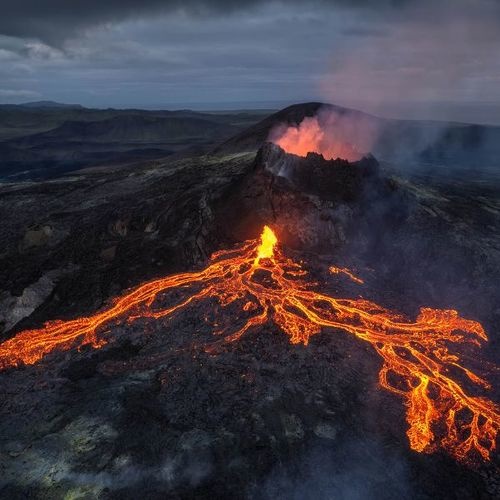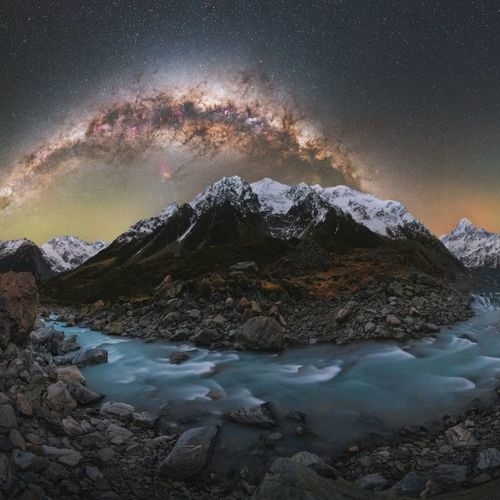One of the absolute highlights of my trip through Costa Rica was rafting on the Pacuare River. It wasn’t just the thrill and adrenaline rush I was after. It turned out to be one of the most exciting and enjoyable ways to fully immerse myself in Costa Rica’s incredible natural beauty.
In case you didn’t already know, the Pacuare River is known as one of the very best rafting spots, not only in Costa Rica, but in the entire world! The rapids can be wild and powerful in certain stretches, while the surrounding scenery feels almost magical. The river begins in the Talamanca mountain range and flows all the way down to the Caribbean coast in Limón Province. Along the way, it winds through dense jungle, dramatic canyons, and gorgeous waterfalls. If you’re lucky, you might even spot some of the most iconic animals in Costa Rica while paddling through the rapids.
Even though it was our very first time rafting, we decided to book this tour, and honestly, it blew us away. If you love adventure and want an unforgettable experience, this is a must-do in Costa Rica.
To make planning easier, I’ve put together this guide with everything you need to know before rafting one of the most breathtaking rivers on the planet (and don’t just take my word for it; National Geographic says so too!).
- Best time to go rafting on the Pacuare River
- Types of rapids on the Pacuare River
- How long does it take to raft the Pacuare River?
- Pacuare River rapids difficulty
- Pacuare River rapids map
- Logistics: how to get there and rafting tours
- What to bring on a Pacuare River rafting trip
- Other river rafting tips
- My experience rafting the Pacuare River
Best time to go rafting on the Pacuare River
A lot of people think the best time to travel to Costa Rica is during the dry season, but here’s some good news: rafting on the Pacuare River is possible all year round. The best time really depends on your rafting experience and the kind of adventure you’re looking for. We went in October, which isn’t usually recommended for first-timers, but luckily, the water levels weren’t high enough to make things unsafe.
- Dry season (December to April): If you’re new to rafting and prefer a calmer, easier ride, this is the best time to go. During the dry season, the rapids usually range from Class III to IV. With far less rainfall, the river levels are lower, the rapids are more predictable, and overall, it’s a safer experience. You’ll also enjoy clear, sunny skies that give you better views of the scenery and more chances to spot wildlife along the way.
- Rainy season (May to November): For adrenaline seekers and those with a bit of rafting experience, the rainy (or “green”) season is the perfect choice. The heavy rains raise the water level dramatically, making the rapids faster, wilder, and even more thrilling, sometimes reaching Class V. The jungle is at its most vibrant during this time, bursting with greenery and wildlife activity (though yes, that also means more insects). If you don’t mind getting absolutely soaked and want a bigger challenge, rafting in the rainy season will definitely get your heart racing.
What types of rapids are on the Pacuare River?
The Pacuare River runs for more than 62 miles, but most rafting tours focus on a particularly exciting 16-mile stretch between the small town of Tres Equis and Siquirres. And here’s the fun part: in this section alone, there are over 50 rapids to keep things exciting, ranging from beginner-friendly runs to challenges for seasoned adventurers.
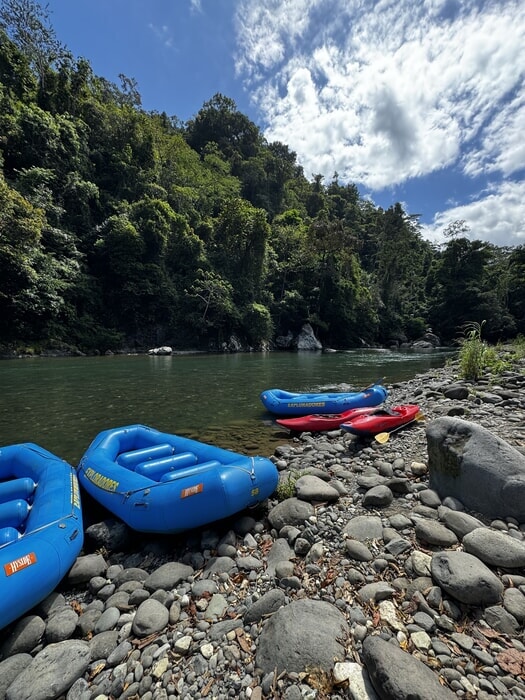
What types of rapids are on the Pacuare River?
While not every rapid has a name, the route is divided into two main sections, each offering a different level of intensity and scenery.
Upper section of the Pacuare River
This part of the river is perfect if you’re new to rafting. The rapids here are generally Class II–III, which means the ride is smooth with just enough excitement to keep things fun. It’s beginner-friendly, and even kids as young as six can join in.
- Pyramid Rock – Class II: One of the very first rapids you’ll encounter in the upper section. It’s like a warm-up run—gentle waves, light currents, and only a few obstacles to navigate. The river narrows here, and one pyramid-shaped rock gives this stretch of rapids its name.
- Pele el Ojo – Class III: This is the biggest area of rapids in the upper section and the one that really shows you the river’s strength, even as a beginner. As the water speeds up, you’ll need to dodge larger rocks while the waves splash over the raft. It’s not overly technical, but it definitely gets your adrenaline pumping in the best way.
Lower section of the Pacuare River
If you’re ready to take your Pacuare River rafting tour up a notch, the Lower Section is where the action really begins. The rapids here are faster and stronger, reaching Class III and IV levels, which means more thrills, more splashes, and a much more dynamic ride. Just keep in mind, though, if you’re traveling with kids, participants need to be at least 12 years old to join tours on this part of the river.
- Rodeo – Class III: This rapid starts by zigzagging between rocks, really putting your paddling skills and coordination to the test. The raft shifts a lot here as the current pushes you hard, with medium-sized waves and some turbulence. There aren’t any steep drops, but the narrow passages keep you on your toes and make this section perfect for building confidence.
- Double Drop – Class III-IV: True to its name, this one comes with two sharp drops and strong rapids that can launch you right out of your seat, especially when the river is running high. The waves are bigger, the currents stronger, and teamwork becomes essential to steer clear of the rocks.
- Upper Huacas – Class III-IV: This rapid sticks with you long after you’ve paddled through it. Toward the end of the stretch, you’ll face a massive boulder right in the middle of the river. With turbulent waves rushing around it, you’ll need quick thinking and coordinated paddling to avoid a collision.
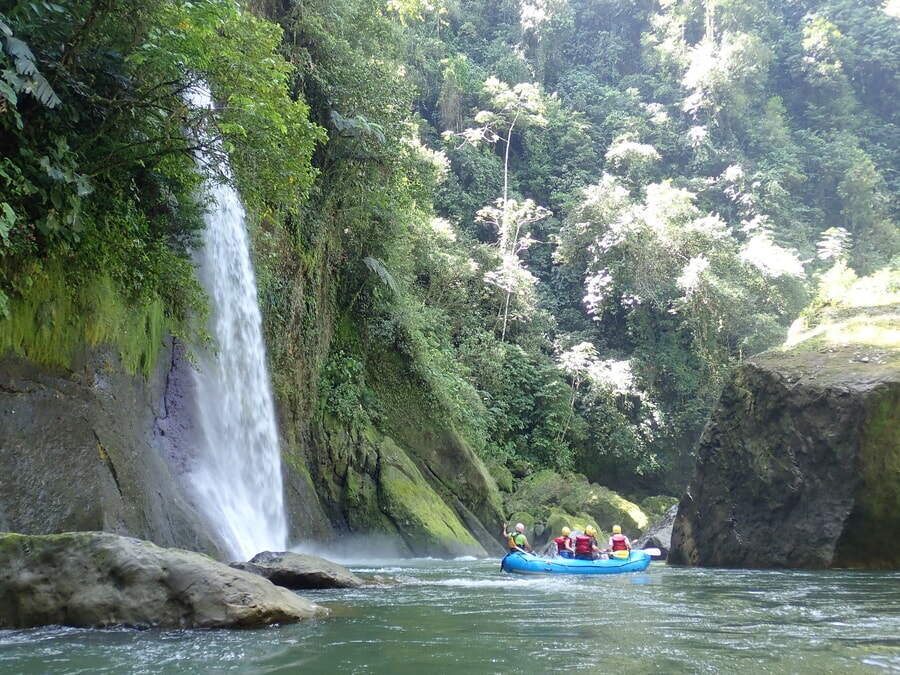
Lower section of the Pacuare River
- Lower Huacas – Class IV: A favorite for thrill seekers! It begins with a steep drop, followed by a fast sequence of narrow, twisting turns that challenge your reflexes and coordination. On top of the excitement, you’ll be surrounded by a gorgeous canyon, its walls thick with lush greenery.
- Pinball – Class III: Split into two parts (Upper Pinball and Lower Pinball), this rapid delivers exactly what its name suggests. You’ll bounce and jump across the waves like a pinball, a mix of pure fun and adrenaline. It’s accessible if you’ve already got some rafting experience under your belt.
- Cimarrones – Class III: Entering the Pacuare Valley, you’ll encounter larger rocks and foamy “pour-overs” (those breaking waves and swirling waters). To make it through safely, precise paddling and technical maneuvers are essential.
- Two Mountains – Class IV: Near the end of the route, you’ll find yourself in the canyon that gives this rapid its name. It’s one last major challenge before finishing; narrow, steep, and demanding full concentration. The ride is intense, but the canyon views are absolutely unforgettable.
How long does it take to raft the Pacuare River?
There are several ways to enjoy rafting on the Pacuare River in Costa Rica, and how long it takes really depends on how much time you’ve got and how deep into the adventure you want to go.
The most popular route, from Tres Equis to Siquirres, usually takes between 3.5 and 5 hours to complete. Timing depends on the river’s flow, the weather, and the pace of your group. Many tour operators also make scenic stops along the way so you can rest, take photos, or simply enjoy the jungle views. In our case, we took this tour from San José and ended up making a whole day of it. The weather was gorgeous, so we even stopped at a calm stretch of the river for a refreshing swim and a picnic-style lunch.
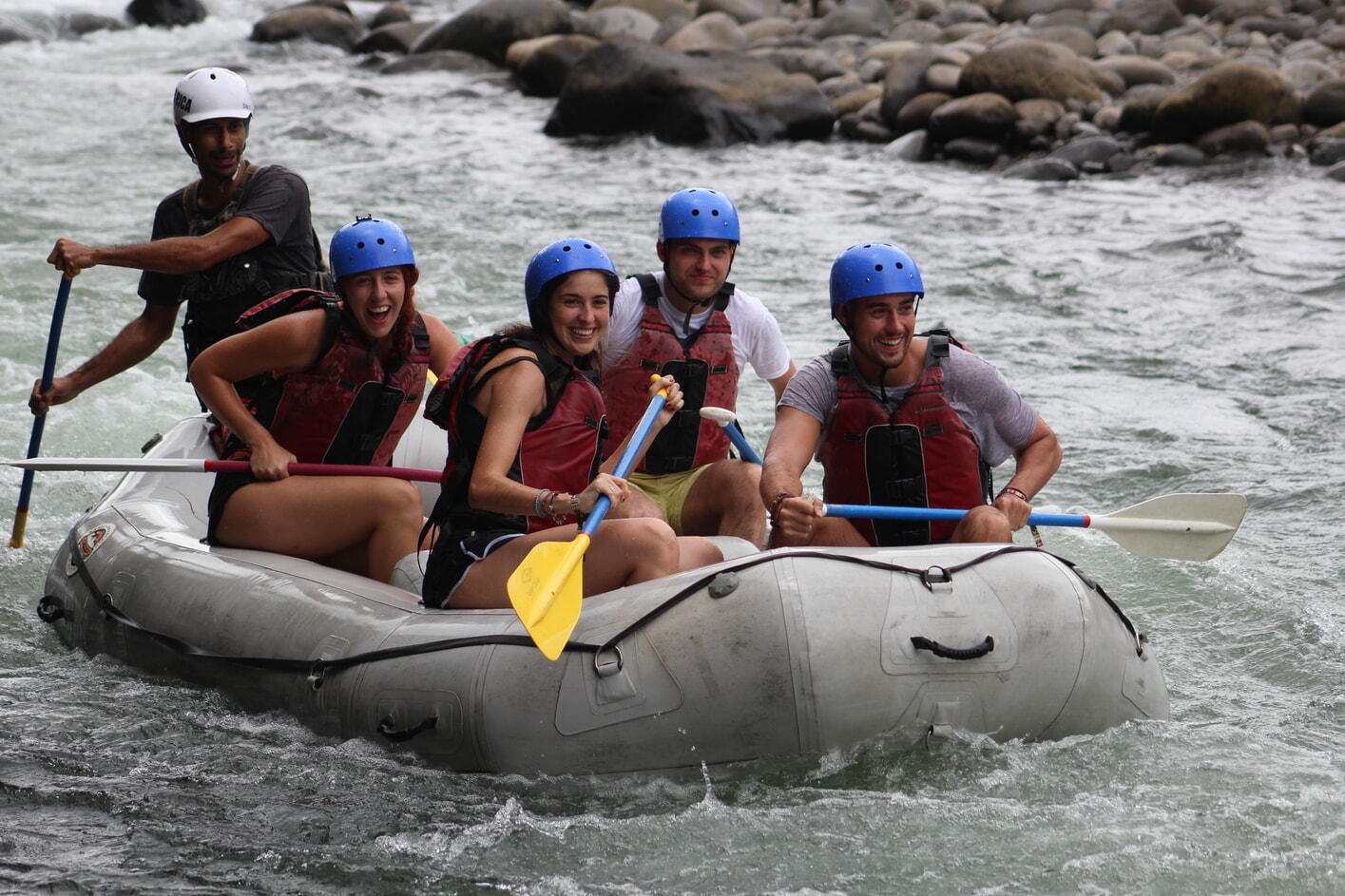
How long does it take to raft the Pacuare River?
If you’re short on time, half-day trips are a great option. These focus on shorter stretches of the river, sometimes only the Upper Section, which lasts about 1.5 to 2.5 hours. That makes them ideal if you only want to try the gentler Class II–III rapids without committing to a full day.
For those craving a more immersive experience, two-day rafting tours on the Pacuare River in Costa Rica are available as well. These trips are designed for travelers who want to soak in the jungle atmosphere, spot wildlife, go on short hikes, or simply slow down the pace. At the point where the Upper and Lower Sections meet, you’ll find several riverside lodges and camping spots.
Here’s how it works: on day one, you’ll paddle through the Upper Section until you reach your lodge, where lunch is served. In the afternoon, you can explore nearby waterfalls, hike through the rainforest, or keep an eye out for wildlife. After spending the night surrounded by jungle sounds, you’ll continue your excursion the next day, tackling the rapids of the Lower Section.
Pacuare River rafting difficulty
To give you some context, river rapids around the world are graded using an international classification system. This system helps measure the difficulty of rapids and the kind of skills you’ll need to handle them, so you know what to expect before hopping into the raft, no matter where you are.
Although I recommend checking out our complete Costa Rica rafting guide for the bigger picture, here’s the quick overview: the Pacuare River is a mix of Class II through Class IV rapids. Here’s what that means:
- Class II: Easy rapids with small waves and simple obstacles. Perfect for beginners.
- Class III: Moderate rapids with larger waves and the need for more steering to avoid rocks and stronger currents.
- Class IV: Intense rapids featuring drops, whitewater, and more technical maneuvers.
As I mentioned earlier, the difficulty of the Pacuare River changes depending on the season. In the rainy months, many Class III rapids become Class IV because of the higher water levels and stronger flow. During the dry season, the opposite happens: Class IV rapids often drop down to Class III, offering a calmer, easier ride.
It’s also worth noting that tours only operate when the river conditions are safe. Even during the rainy season (May through December), guides carefully monitor the water level. If the river rises above safe limits, certain stretches may be skipped by hiking around them on jungle trails.
Pacuare River rapids map
To help you picture the adventure a little better, here’s a handy map showing the rapids along the Pacuare River:
Pacuare River rafting logistics: How to get there and tours
Now that you’ve got a good idea of what rafting on the Pacuare River is like, let’s talk about the practical side: how to actually organize your trip. Since this is one of Costa Rica’s most popular excursions, there are tours for every kind of traveler, no matter your budget or level of experience.
If you’re renting a car in Costa Rica, the easiest and most affordable option is to drive to the town of Turrialba and join a rafting tour from there. If you want to travel on a budget, this tour is a great choice. It’s for small groups, which means a more personal and friendly atmosphere, which is especially great if it’s your very first time rafting.
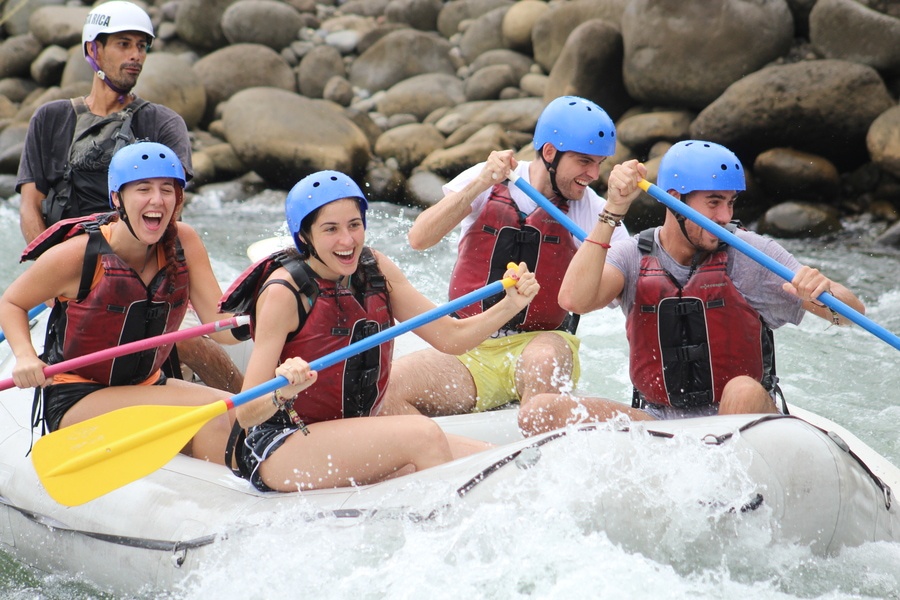
Pacuare River rafting logistics: How to get there and tours
But if you want to join one of the tours from San José, you’ll find plenty of excursions that depart directly from the city. This tour is the option we chose, and it turned out to be perfect for a quick day trip out of the city. Just keep in mind that these tours tend to be a bit longer, since San José is about 42 miles from the river’s starting point, which takes around an hour and a half each way. I’ll share more about our personal experience later, but spoiler: it was fantastic, and it even included lunch.
Finally, if you have a little more time to spare and want to go deeper into the experience, you can sign up for a two-day rafting tour on the Pacuare River. These tours can be arranged directly with accommodations located between the Upper and Lower Sections of the river. If you also need transportation from San José, I recommend booking this full tour package. It includes two days of rafting, guided jungle hikes, all meals, and one night of accommodation right in the heart of the rainforest.
Accommodation options near the Pacuare River
Imagine waking up in the heart of the jungle, with birds calling overhead and the steady sound of the river flowing nearby. If that idea excites you, here are some great lodging options along the Pacuare River that fit different budgets and travel styles:
- Luxury accommodation: The Ave Sol River Sanctuary is an eco-retreat with rustic yet comfortable cabins made from sustainably harvested wood sourced from their own 121-acre private reserve. Each cabin comes with cozy beds, sturdy roofs, and large windows that let you enjoy the surrounding scenery. Meals are included, but there’s also a fully equipped kitchen and dining space if you prefer to prepare your own food. Extras like a hammock lounge and bar make it easy to unwind after a day of adventure.
- Mid-range accommodation: If you’re looking for luxury in the middle of the rainforest, the Pacuare Lodge by Böëna is hard to beat. With elegant suites and villas overlooking the mountains, a year-round outdoor pool, a terrace, and a full-service bar, it combines comfort with nature. The on-site gourmet restaurant offers fusion dishes and even has a curated wine cellar with bottles from around the world, making it ideal for a more indulgent escape.
- Budget-friendly accommodation: The Pacuare River Lodge has 14 simple bungalows tucked into the rainforest with beautiful river views. It’s the perfect spot to relax and recharge after a rafting trip without breaking the bank. Your stay includes all meals, starting with lunch on your arrival day and ending with lunch on your departure day. As a bonus, guests also get free use of kayaks to explore the river at a slower pace.
What to bring for rafting on the Pacuare River
So, you’ve decided to take on the Pacuare River. Great choice! But before you grab your paddle and hit the water, let’s make sure you’ve packed everything you’ll need for a smooth and enjoyable trip. Whether you’re going for just the day or spending the night in the jungle, being prepared makes a big difference.
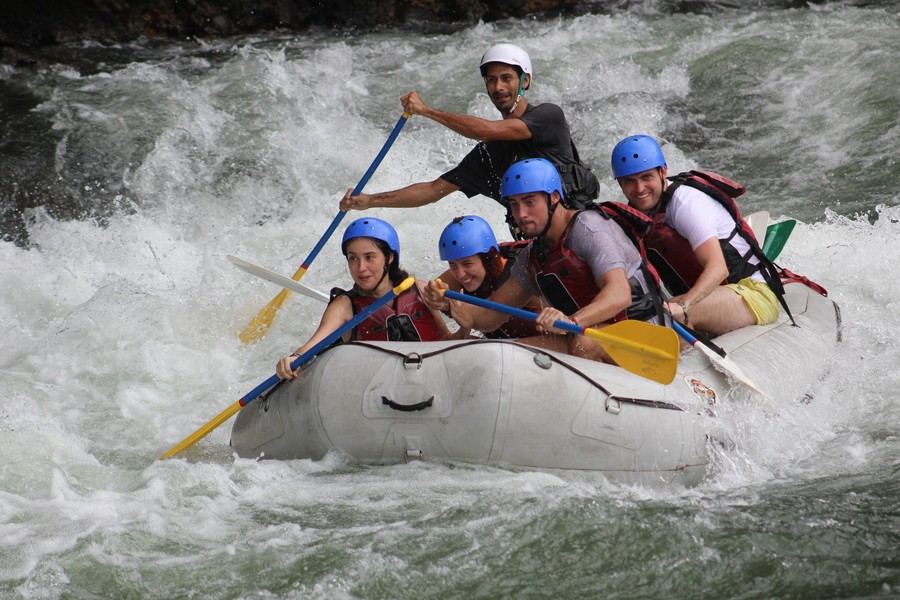
What to bring for rafting on the Pacuare River
Don’t worry; tour operators will provide the essential gear, like helmets, life jackets, and paddles. But there are a few personal items you’ll definitely want to bring along:
- Swimsuit
- Water shoes or closed-toe shoes that can get wet (avoid flip-flops—you’ll lose them instantly!)
- Quick-dry clothing
- Sunscreen (water-resistant is best)
- Insect repellent
- A full change of clothes for after the tour
- A towel (showers and changing rooms are usually available afterward)
- A waterproof bag if you’re carrying valuables
- Straps for glasses if you wear them
One question many people ask: Should you bring your phone? Honestly, we didn’t, and I’d recommend leaving it behind unless you have a completely waterproof case. It’s easy to lose it in the rapids, and the risk just isn’t worth it. Luckily, our tour had a professional kayak photographer paddling alongside us. Afterward, we were able to purchase the full set of photos for $50.
Other tips for rafting on the Pacuare River
You’re almost all set! Before you grab your paddle, here are a few final tips I wish I’d known before heading out on the Río Pacuare:
- Go during the right season. If you’re looking for a wilder and more challenging adventure, go during the green season when the river runs stronger. If you’re a beginner and want a calmer ride, choose the dry season between December and April, when there’s less rain.
- Ride with a certified operator. Make sure the company you book with has IRF-certified guides and well-maintained equipment. Safety always comes first.
- Be physically ready. Rafting isn’t just sitting in the raft; you’ll need to paddle hard at times, so it helps to be in decent physical shape.
- Wear your safety gear correctly. Keep your life jacket and helmet on at all times, and don’t take them off until the adventure is over.
- Learn the commands. Your guide will teach you the basics, but it’s useful to know them in advance. Commands like “Forward,” “Back,” “Stop,” “Left,” and “Right” are essential. If you’d like to practice before your trip, I explain them in detail in my article on rafting in Costa Rica.
- Always listen to your guide. They’ll give you clear instructions that are key to both your safety and your enjoyment.
- Stay inside the raft. If you do fall into the water, don’t panic. Float with your feet pointing downstream and wait until your guide helps you back in.
- Leave valuables behind. Anything not strapped down can easily be tossed out by the rapids, and there’s no chance of getting it back.
- Respect nature. Don’t throw trash into the river, and avoid feeding wildlife. Keep the jungle as pristine as you found it.
My rafting experience on the Pacuare River
To wrap up this guide, let me tell you about my experience rafting on the Río Pacuare in Costa Rica.
Our adventure started bright and early in San José. At 5:45 a.m., a van from the tour agency picked us up. Honestly, at that hour, all I could think about was coffee, so I barely noticed the butterflies in my stomach that had kept me awake the night before.
It took us about two hours to get to Siquirres, the starting point. Once there, we were treated to a big breakfast of gallo pinto, fried plantains, tortillas, and fresh fruit; exactly what we needed to fuel up. While eating, we met our guides, and right away, I felt confident we were in good hands.
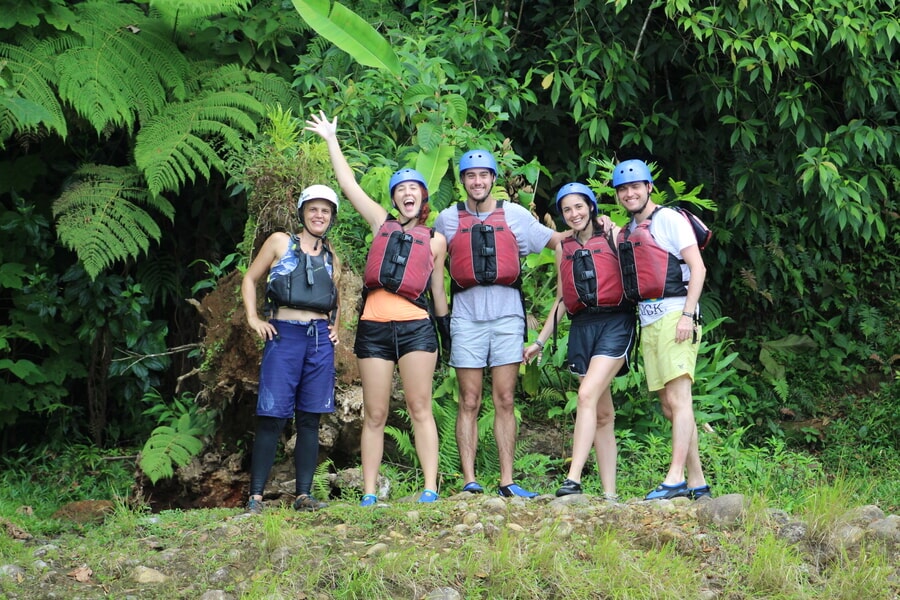
Our group ready to raft along the Pacuare River
They patiently taught us the paddling commands, and we practiced as a group until we got the hang of them. That little warm-up helped us shake off our shyness and bond with the others in our group: two Canadian girls, a German guy, and a French woman, who ended up in a second raft. In my raft, it was me, my brother, and two cousins. Once ready, we changed into our swimsuits, hopped back on the bus, and headed to the riverbank.
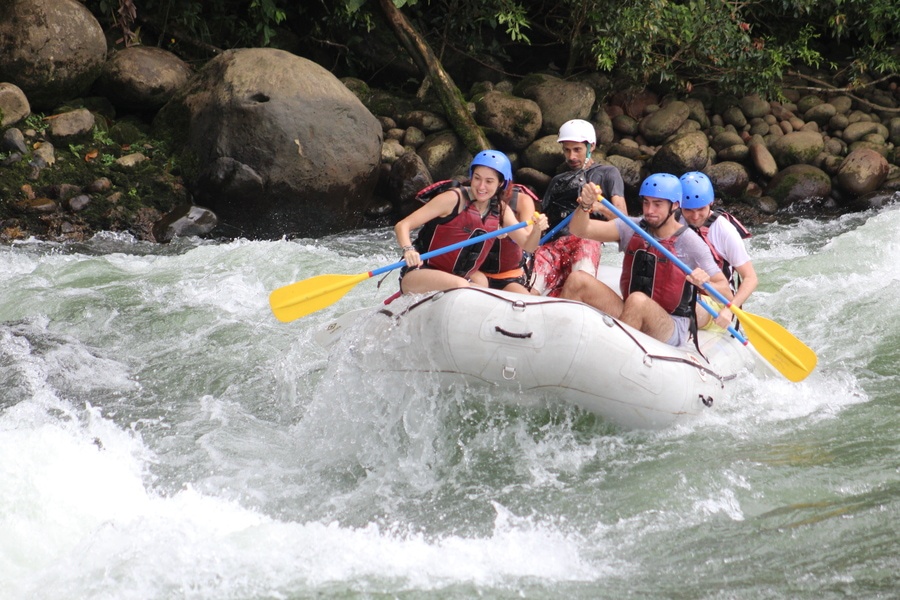
Practicing rafting commands on the Pacuare River
The first few stretches of the river were calm, giving us a chance to practice the maneuvers. But soon enough, the Pacuare revealed its true character: waterfalls crashing down on both sides, waves splashing over us, and rapids rocking the raft like crazy. We laughed nonstop, even when my cousin fell out during one of the rougher sections and had to be rescued by the second raft. (Don’t worry; she was fine, and they returned her to us when we stopped for lunch.)
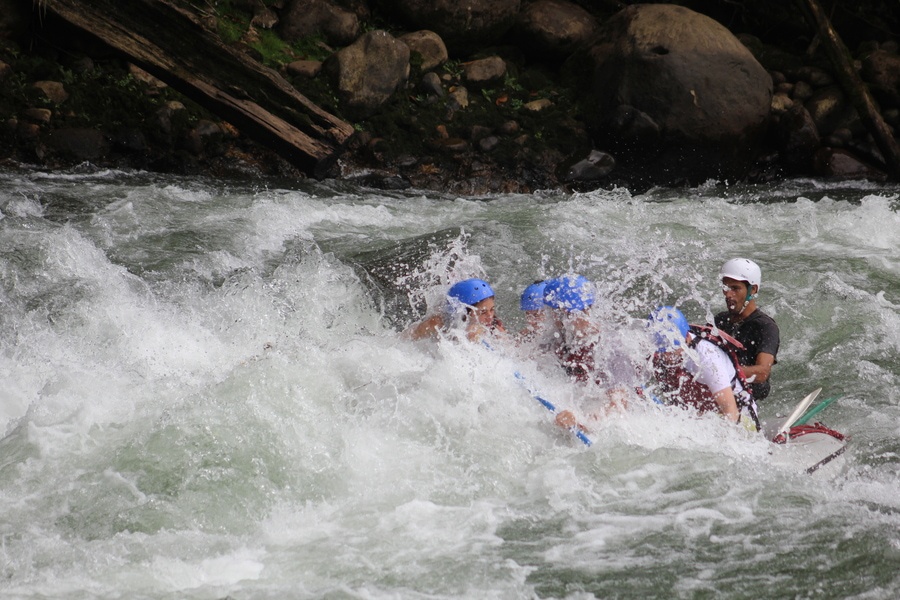
One of the falls on the Pacuare River while rafting
At midday, we paused on a calmer part of the river for lunch. After eating, we got to jump into the water, swim around, and let ourselves drift gently with the current. Floating there, surrounded by the lush rainforest, was unforgettable. We even spotted monkeys swinging in the trees, which was a magical moment that added to the thrill of the day.
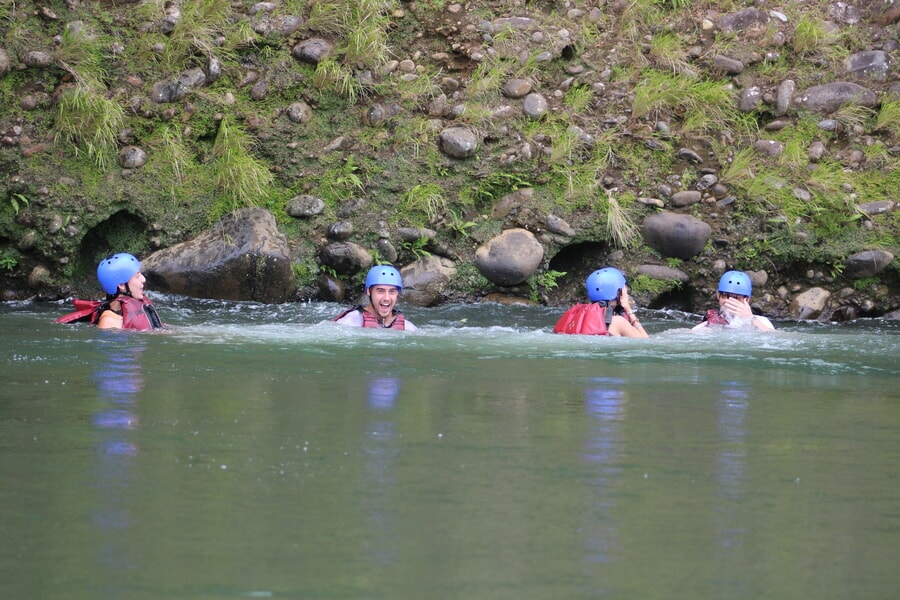
Swim break along the Pacuare River
Of course, by then, we weren’t alone on the river anymore. We crossed paths with other tour operators’ groups, and the last section felt a bit busier compared to the first stretch, which had been just us, our guides, and the photographer’s kayak. Still, the energy and excitement didn’t fade.
When we finally reached the end point, the minibus was waiting to take us back to base camp. There, we changed into dry clothes and bought the photos taken during the trip. It was worth every penny to remember the adventure.
It was a truly spectacular day, and one of the most exciting experiences I’ve had in Costa Rica. That’s the magic of rafting on the Río Pacuare: adrenaline mixed with pure fun. I hope this guide inspires you to try it for yourself. And if you do, or if you’ve already been, drop me a comment. I’d love to hear your story.
Pura Vida!
